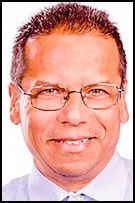McMinnville School Board: Partida and Aase seeking Position 5


Audrey Aase is challenging incumbent Gerardo Partida for Position 5 on the McMinnville School Board.
Partida has served on the school board for four-and-a-half years. He was appointed, then elected in 2019.
He has been a real estate broker and now works for Community Home Builders, which helps people obtain low-cost loans and work together to build their homes and those of their neighbors.
After graduating from high school in Mexico, Partida earned a bachelor’s degree in fisheries from Marine Science School. He later completed courses for his real estate license.
He volunteered for the McMinnville School District’s Hispanic Parents Committee for two-and-a-half years and for the district’s School Budget Committee for four years before joining the board.
Aase is a hairdresser who owns her own business, Audrey’s Beauty Shop. She attended McMinnville schools. After graduating from McMinnville High School, she completed the Academy of Hair Design to become certified and licensed.
She has children attending McMinnville schools.
Audrey Aase
As a board member, Aase said, she would represent teachers, parents students and the community and set budgets and policies that best fit their interests and lead to success.
“I would put my time and energy as required to be an effective and informed leader,” she said. “I can listen to all sides of an issue and facilitate compromising solutions.”
During the coming four-year term, Aase said she expects to deal with issues such as lack of transparency in curriculum, safety, the need for security resource officers on campus, need for teacher - parent involvement and consequences and accountability for inappropriate behavior. “I am ready for anything,” she said.
The three main responsibilities of a public educator are to ensure all students are prolific in all subjects, prepare students for the real world and the workforce, and help students reach their full potential, Aase said.
Oregon schools follow curriculum and performance standards set by the state Department of Education. “I believe there should be some sort of state standard, but within that standard, each district should have more authority on the curriculum and performance standards,” Aase said. “Teachers and parents in each district should weigh in heavily on those issues.”
She said she sees a need for more transparency in the curriculum and more parent awareness and involvement.
“Many parents are unaware of certain things being taught in school,” Aase said. She worries about “schools not informing parents if there is any discussion with their child about gender affirmation in the classroom or counseling sessions. That is not OK, period.”
“Gender fluidity has no place in a K-12 curriculum,” she said. “A child does not know yet what it truly means to be a man or woman. Instead of clouding their minds with that confusion and distraction, we need to focus on academics and behavior.”
Aase said she also finds it worrisome that students are not always being held accountable for their work and their actions. They need to be accountable and realize there are consequences. “The bar needs to be set higher, not lower,” she said.
She also called for the dress code to be enforced at Mac High. “Students need to have respect for themselves and others,” she said.
“We want our students to go to school to become prolific in academics and in real-life coping skills,” she added.
She is pleased that the district and city have been meeting to talk about shared facilities; that will benefit the community, she said.
As far as facilities go, some are adequate and others are not, Aase said. The high school is crowded, and athletic facilities need work, including the tennis courts and swimming pool.
Aase said she is pleased by how easy the district makes it for parents to be involved. She likes the Parent Square communication tool, which keeps families involved about dates, activities and field trips; it helps parents stay involved and keeps them in contact with their children’s teachers.
However, she feels that communication between the district and community members who don’t have children in the schools is “pretty limited.”
“Community members need to know graduation rates and how the students are performing,” she said. “They should be informed on any fundraisers for the district that may be happening.
Aase also appreciates the career pathway courses at Mac High. The district has many “really great teachers and principals,” she said.
Gerardo Partida
Partida said the main duties of a school board member are to set vision and goals, design and approve policies and procedures, approve an annual budget, and to hire and evaluate the superintendent. He served on the board when the current superintendent, Debbie Brockett, was hired following a nationwide search.
He said he represents the entire community as a board member who “advocates for all students and staff.”
His abilities to work as a team and collaborate with other board members, the community and staff make him an asset, he said. He is able to take advantage of opportunities to grow and support our district goals toward our students’ success.
During the next four years, he said, the district will be working to maintain its enrollment, which fell during the pandemic but has returned to near-post-COVID levels. “Also, one the most important things we must focus on is the social and emotional learning and support all students that suffer loss of learning due to the pandemic,” he said.
Public education must “focus on students success, providing an effective and quality education to all our students to be sure they become productive citizens in our community,” he said. The district must educate students in order to develop a qualified workforce, he said.
“The district also needs to develop a system to create an informed community,” he said.
While the state sets standards for all Oregon school districts, Partida said, “our district designs and implements curriculum and performance standards based on students’ needs as well as meeting state standards.”
Partida said the state and local community must invest in educators and support for schools. That’s essential to make learning possible, he said; educators are an important part of making our community, state, and nation more educated for a better future.
He has seen the district and board making changes to better serve students, he said.
For instance, he praised the district’s communication system, which is necessary to share ideas, comments and concerns about challenges within the district and students’ progress. Communication encourages support, which in turn allows students to reach their maximum potential.
“Parents and community involvement is important to make efforts to support students and ensure they have the tools to improve their academic outcomes,” he said. “Families and community members have access to multiple platforms where they can ask questions, provide comments and concerns.”
As for facilities, the school board’s facilities subcommittee meets with staff monthly to review and analyze possible upgrades or repairs needed to facilities. They talk about how facilities currently are working now, and how they can support educational programs in the future.
“As of right now, we have enough functional space to serve our students, but we can expand depending on our future student enrolment,” Partida said.
Board members also talk frequently about athletic facilities and programs, discussing how they are working now and what’s needed in the future.
Once an athletic or academic need is identified, he said, school district staff, school board, families, and community members “all have to work together to figure out what to do and support and better our students.”













Comments